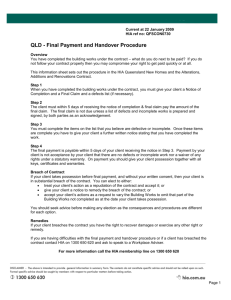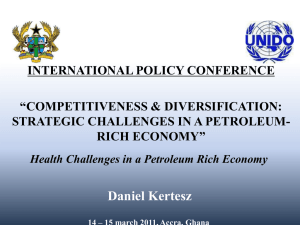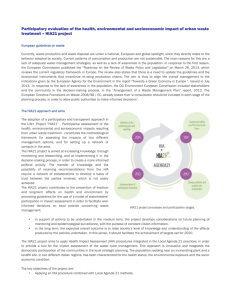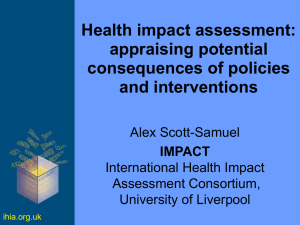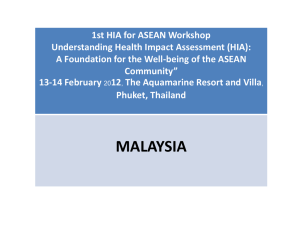Health Impact Assessment Introduction Massachusetts Healthy Transportation Compact
advertisement
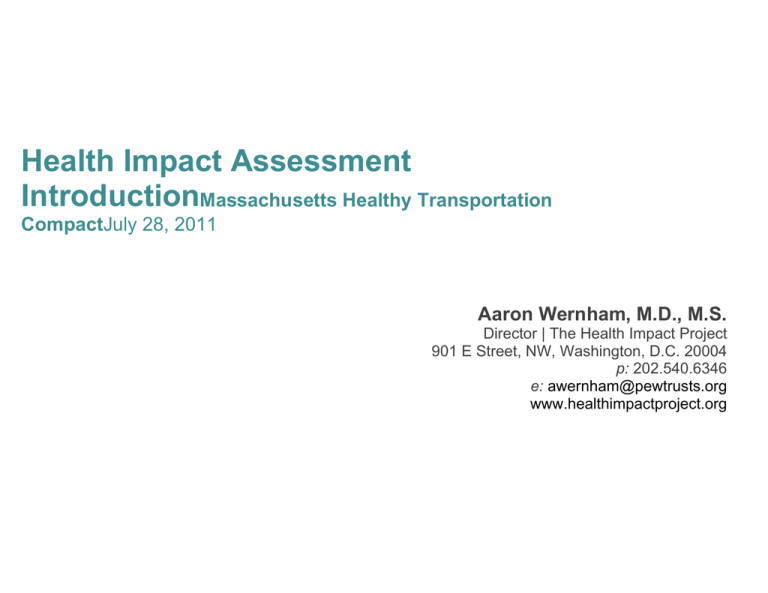
Health Impact Assessment IntroductionMassachusetts Healthy Transportation CompactJuly 28, 2011 Aaron Wernham, M.D., M.S. Director | The Health Impact Project 901 E Street, NW, Washington, D.C. 20004 p: 202.540.6346 e: awernham@pewtrusts.org www.healthimpactproject.org Outline 1. 1.Why do we need HIA? 2. 2.Introduction to HIA: basic definitions, process, and state of the practice 3. 3.Brief case examples 4. 4.Common concerns and challenges The U.S. spent $2.5 trillion on health care in 2009 My child’s asthma is out of control… Transportation Housing “Eat more fruits and vegetables…” Food Deserts Public health: A new multidisciplinary focus “Public health agencies alone cannot assure the nation’s health.” Institute of Medicine, 2002. The Future of the Public’s Health in the 21st Century “Non-health” policies: An emerging priority for public health Opportunities for prevention increase when those working in housing, transportation, education, and other sectors incorporate health and wellness into their decision making. National Prevention Council, 2011 How do we put this into practice? • No common language: o transportation engineers don’t understand health data o public health professionals don’t understand the constraints and limitations of the planning process • Few formalized requirements • No routine interaction between health and other sectors • Priorities don’t necessarily match: o Public health is one consideration of many; transportation decisions involve many other considerations (moving people, funding, technical limitations, local politics, etc) HIA: Definitions A combination of procedures, methods and tools that systematically judges the potential effects of a policy, program or project on the health of a population and the distribution of those effects within the population. HIA identifies appropriate actions to manage those effects. World Health Organization, adapted by the International Association of Impact Assessment, 2006 Health Impact Assessment • A practical approach to aid decisions on specific proposals—new policies, projects, programs and plans—that have a potential for health risks or benefits. • Provides a decision maker with public health data and input in a structured, organized way. • Focuses on solutions: develops practical recommendations, informed by both public health priorities AND the economic, technical or political constraints on the decision. HIA ExampleJack London Gateway rapid HIA Topic of HIA: proposed housing development of 61 senior housing units near two major freeways and the Port of Oakland. Health Risks: Source: Human Impact Partners, http://www.humanimpact.org/component/j downloads Jack London Gateway rapid HIA Outcomes: 1. 1.Air Quality – developer implemented air filtration; changed windows facing freeway. 2. 2.Noise – developer added a noisebuffered courtyard and entranceway Source: http://humanimpact.org/JLG_case_study_draft.pdf away from the highway 3. Safety – recommendations for “traffic calming” measures (speed bumps, wider sidewalks with narrower lanes, safe cross walks) to allow residents walking access to nearby retail. Under consideration. Health Impact Assessment: Origins in International practice Origins/approaches: • integrated with EIA • urban planning, HiAP World Bank and IFC: part of evaluation standards for large development loans Multinational Corporations (e.g. Shell, Chevron, large mining companies) Business case for HIA • Lower business costs • Corporate social responsibility • Healthy workforce • Risk management Completed and In Progress HIAs 1999–2011: 113 WA 3 MT 1 OR 16 ME 1 MN 5 NH 1 MI 1 MA 4 PA 1 NJ 1 OH 1 IL 1 CO 2 CA 46 MO 1 DC 1 KY 1 MD 2 TN 1 NM 2 SC 1 GA 7 TX 2 AK 8 Federal HIAs: 2 HI 1 Map Courtesy of A. Dannenberg, A. Wendel, CDC NCEH. The Health Impact Project is a collaboration of the Robert Wood Johnson Foundation and The Pew Charitable Trusts. Topics of HIAs: A wide spectrum • •Land use and transportation: comprehensive planning, siting, corridor planning, road projects, transit and TOD • •Natural resource development: oil and gas, mining • •Energy projects: coal, biomass • •Policies: o o o o o MA LIHEAP MA rental vouchers Paid sick days California carbon cap & trade New Hampshire state budget • •Food and Agriculture: farm to school legislation, county agricultural plan The HIA Processhttp://www.healthimpactproject.org/hia/process 1. 1.Screening – decide whether HIA should be done: is the HIA going to add new information? Does it fit within the timeline? 2. 2.Scoping – develop framework for HIA: the important health effects, affected populations, available evidence 3. 3.Assessment – A)analyze baseline conditions; B) predict potential effects 4. 7.Recommendations – develop health-based recommendations and a feasible plan for implementing them 5. 8.Reporting – produce a report; disseminate the results (interim and final) to decision makers, public, other stakeholders 6. 9.Monitoring and Evaluation – HIA process; impact of doing HIA; outcomes of implementing HIA/decision “HIA 2.0” – beyond project-specific applications • •Should a new HIA be done for each new project or program? • •Can HIA be a formative learning tool that results in adoption of new “healthy by design” principles that obviate the need for HIA on every projects? “HIA 2.0” – beyond project-specific applications Ingram County, MI (Lansing): Local health dept now using “HIA Checklist” This website has case study and link to the checklist: http://www.cacvoices.org/healthylifestyles/environmental/HIA/ “HIA 2.0” – making health-based planning more routine Ingram County, MI (Lansing): Local health dept now using “HIA Checklist” This website has case study and link to the checklist: http://www.cacvoices.org/h ealthylifestyles/environme ntal/HIA/ Health Impact Assessment: Common questions 1. 1.Is HIA going to lead to a longer planning and permitting process, greater costs and increase the potential for litigation? 2. We already address air quality, traffic flow, connectivity and other factors that influence health. What will HIA add? Health Impact Assessment: Common questions 1. 1.Is HIA going to lead to a longer planning and permitting process, greater costs and increase the potential for litigation? • Most HIAs are done for ~$10,000-$150,000. • HIAs should be done within the timeframe for the decision—we have not seen any examples of delay • Delays often come from opposition and litigation: proactively addressing concerns is a way to build support and prevent litigation • Duty to warn: failing to disclose potential risks generally creates a greater risk. Health Impact AssessmentCommon questions 2. We already address air quality, traffic flow, connectivity and other factors that influence health. What will HIA add? • Baseline health data: where are the vulnerable populations and needs: e.g. high asthma or obesity rates, traffic injury hotspots, food deserts. • Differentiating alternatives • Addressing community concerns, adding a trusted voice • Building support for a well-planned project • New partnerships for future decisions • If it doesn’t add anything, don’t do it! (remember screening) Thank you Aaron Wernham Director, Health Impact Project The Pew Charitable Trusts 202-540-6346 awernham@pewtrusts.org Massachusetts Low Income Energy Assistance Program Policy Question: energy prices spiked after Katrina, increasing the financial burden for families. Should LIHEAP funds be increased? Health Effects: • Pneumonia • Burns implications for Medicaid expenditures • CO poisoning • Hunger and poor nutrition Recommendations and Outcomes: • Increased funding for LIHEAP • New evaluation parameters to ensure adequate data on outcomes of program “HIA 2.0” – beyond project-specific applicationsThe Healthy Development Measurement Tool Example: Pittsburg Railroad Avenue TOD HIA Proposed action: • New BART (light rail) station • 1600 new housing units • 446,000 sq. ft. retail • Parking • Pedestrian and biking improvements HIA Findings: Baseline health status Health Baseline: Pittsburg (CA in parentheses) • • • • • •Heart disease mortality 220/100,000: (180/100,000) •Adult obesity + overweight: 60% (57%) •Child Obesity + overweight: 44% (27.5%) •Depression: 23% (21%) •Injury deaths: 28.7/100,000 (26.4/100,000) Health risks (“health determinants”) Air pollution in residences near highway 4; less walkable neighborhoods; less access to full-service grocery stores; neighborhood safety HIA Findings: Potential health risks and benefits 1. 1.Improved walking access to retail services and transit (grocery stores, etc.) o decreased risk of crime, obesity 2. 2.Increased vehicle trips AND walking trips in surrounding neighborhood: o injury risk 3. 5.Noise: new buildings near highvolume freeway o risk of sleep disturbance o high blood pressure HIA Recommendations and Outcomes: 1. 1.Access to retail services: needs assessment; incentive for supermarket; zoning to prevent fast food and liquor outlets. 2. 2.Transportation: o Traffic calming o Improve sidewalks; bike lanes; bus service 3. 3.Noise: interior courtyards, acoustic shielding, sound barrier on HWY 4.
